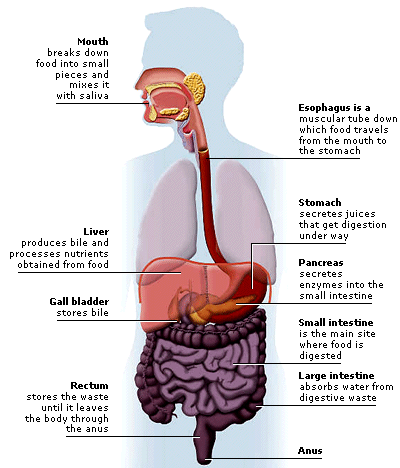DK Science: Digestive System
The job of the digestive system is to break down the food we eat into smaller units called nutrients. The nutrients are then absorbed into the bloodstream and fuel the body’s activities. The MOUTH takes in food and begins the digestive process, which continues in the STOMACH. The food then passes to the INTESTINES, which complete the process. Enzymes – substances that speed up chemical reactions in the body – play a key part in breaking down food.
The digestive system consists mainly of a long muscular tube, the digestive tract. This starts at the mouth, continues via the oesophagus and stomach to the intestines, and ends at the anus. The system also relies on the pancreas, liver, and gall bladder to help digest food. Each day the pancreas releases about 1.5 litres (2 1/2 pints) of enzyme-containing juice into the tract. The liver produces about 1 litre (1 3/4 pints) of bile, which is stored temporarily in the gall bladder.
The mouth is a cavity formed between the tongue at its base, cheeks at the side, hard and soft palate in its roof, and teeth at the front. The teeth tear and grind food, which is then churned through movements of the jaws and tongue. Breaking the food into smaller pieces creates a larger surface area for the action of enzymes in saliva; these begin to digest the food.
Each tooth has a crown, which can be seen above the gumline, and one or more roots, which are embedded in the jawbone. In the centre of the tooth lies the pulp cavity, which contains blood vessels and nerves. This is surrounded by dentine, a strong material that forms most of the tooth. The outer layer of the crown is made of enamel, the hardest substance in the body.
These glands produce a mucus-rich fluid, saliva, that moistens food and so helps form it into a ball, called a bolus, that is easily swallowed. Saliva also contains enzymes that begin the digestive process. When food enters the mouth, the brain sends messages to the glands, triggering a rush of saliva. Food must mix with saliva before it can stimulate the taste buds, which check that the food is safe to eat.
Teeth come in four main types: incisors, canines, premolars, and molars. Each is shaped for a specific function. People have two sets of teeth during their lives: the 20 milk teeth emerge between the ages of about six months and three years. The 32 permanent teeth (like those seen here) emerge from the age of about six years into the early twenties.
The stomach is a muscular bag that begins the digestive process. On entering the stomach, food is mixed with gastric juices and churned by contractions of muscles in the stomach wall. Food usually stays in the stomach for about four hours. By that time, it has become a semi-liquid (called chyme) that can be released in spurts into the duodenum, the first part of the small intestine.
The intestines form a continuous tube that is about 8 m (26 ft) long in adults. Food is pushed along this tube by contractions of muscles in the intestinal walls. In the small intestine, muscle contractions mix chyme with enzymes produced by the pancreas and intestinal lining. It is here that nutrients are absorbed into the bloodstream. In the large intestine, water is absorbed from the digestive waste, and the remaining waste is formed into stools.
The lining of the small intestine has a huge surface area due to the folds in its lining as well as villi, tiny fingerlike structures that project from the lining. Once digested, nutrients are absorbed into tiny blood vessels within the villi. They are then carried in the blood to the liver for processing. Food can remain in the small intestine for up to five hours.

